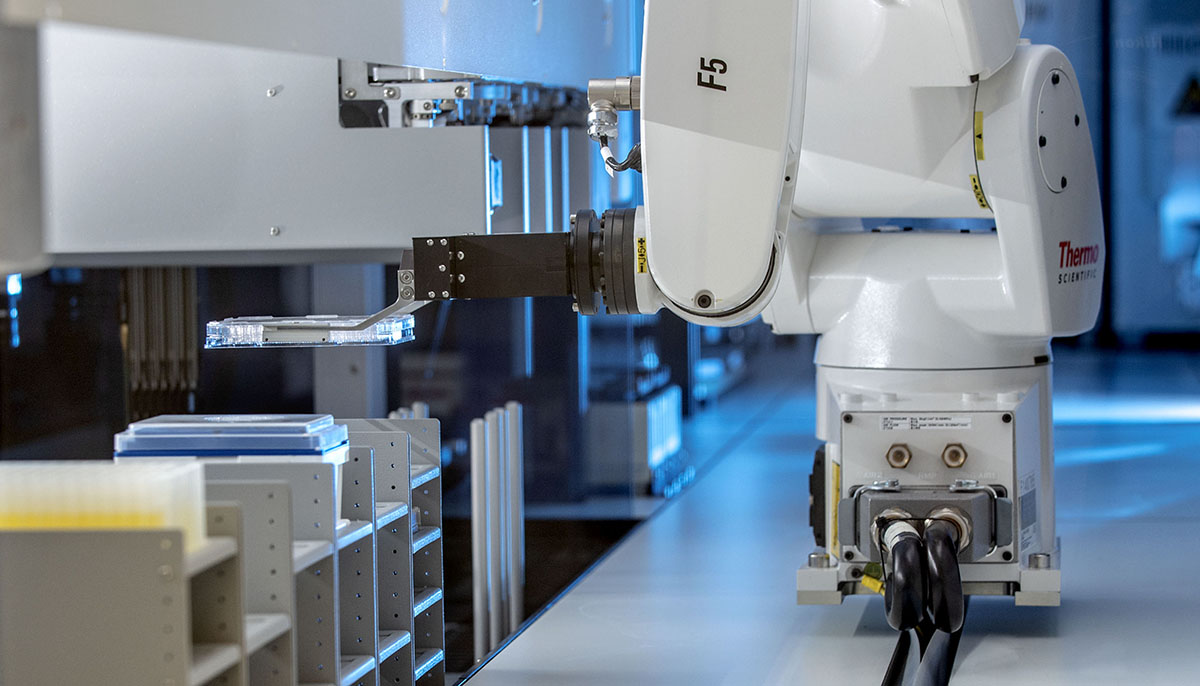15 Years of IGB: Accelerating biological engineering through automation and artificial intelligence
One of the biggest challenges in traditional laboratory settings is performing countless hours of error-prone lab work: handling reagents, incubating reactions or living cells, synthesizing products, applying treatments, and monitoring outcomes. The Illinois Biological Foundry for Advanced Biomanufacturing was established in 2014 to bypass these cumbersome procedures and support a broad array of research goals.

“iBioFAB highlights the potential of team-based research to achieve goals that would be unreachable for the individual,” said Gene Robinson (GNDP), the Carl R. Woese Institute for Genomic Biology Director and Swanlund Chair in Entomology. “Only in an interdisciplinary environment such as the IGB could such a system be not only conceived, but successfully constructed, implemented, and used to the realization of its full potential.”
Developed under the leadership of Huimin Zhao (BSD/GSE/CABBI/MMG/CGD), Steven L. Miller Chair in Chemical Engineering and the Director of the Molecule Maker Lab Institute, iBioFAB is a precisely engineered set of robotic components combined with a highly adaptable software platform. Based in the concourse research lab of the IGB, iBioFAB integrates artificial intelligence/machine learning with automation, and features a robotic arm that travels along a 5-meter-long track to transfer microplates among more than 40 instruments installed on the platform.
The system houses three liquid handling devices that serve as workhorses for most tasks. Additionally, to enable unattended automated operation, iBioFAB also contains instruments for automating standard laboratory tasks: a centrifuge, a barcode labeler, four reagent dispensers, four thermal cyclers, an automated microplate heat sealer, a plate seal remover, and multiple plate shakers and block arrays. At its maximum capacity, iBioFAB can generate thousands of output samples each day using custom-designed workflows.
Although many fields have already turned to automation, several factors make synthetic biology’s transition using iBioFAB unique. First, an automated system that produces synthetic biological systems has to take the unpredictability of biology into account. Second, it must be versatile enough to deal with multiple research efforts. In the pharmaceutical industry, for example, automated systems are used for only one task. But in synthetic biology, researchers could be using the system to work on one project one day, and another project the next day. Third, workflows in synthetic biology are complex and therefore the system needs to be adaptable and programmable. And fourth, it needs to deal with data-rich projects; while a researcher might struggle to remember a genome with thousands of genes, an algorithm can keep track.
From 2013-2019, seven papers have been published that highlight iBioFAB’s usefulness. Plasmids—small, circular DNA molecules—are used by scientists to introduce new genes into a target organism. Known for their applications in the production of therapeutic proteins like insulin, plasmids are broadly used in the large-scale production of many bioproducts. However, designing and constructing them remains one of the most time-consuming and labor-intensive steps in biology research. To address this issue, researchers at the Center for Advanced Bioenergy and Bioproducts Innovation developed a versatile and automated platform for plasmid design and construction called PlasmidMaker. Once the plasmid was designed, it was built with iBioFAB. With all the improvements it brings to the table, the team members at CABBI hope that PlasmidMaker and iBioFAB will accelerate the development of synthetic biology for biotechnological applications.
In addition to synthesizing DNA, iBioFAB can also edit it. Genome editing tools that can target specific DNA sequences are becoming increasingly important in health, industrial, and food biotechnology applications. However, designing and implementing such tools on a large scale has always been a challenge. Due to iBioFAB, IGB researchers have been able to develop recombinant transcription activator-like effectors and transcription activator-like effector nucleases that can be tailored to specifically target any user-defined DNA sequence. Both TALEs and TALENs can be synthesized efficiently and a low cost, making it easy for researchers to use this tool.
The automated platform of iBioFAB can also create multiple DNA edits, including overexpressing some genes while deleting others, in a single step. Developed in 2017, the genome-scale engineering was carried out in Saccharomyces cerevisiae, an important eukaryotic model organism and widely used microbial cell factory. Such manipulations have since helped researchers to quickly identify and improve diverse cellular pathways, including those involved in the production of enzymes and chemicals.
In 2019, researchers at Illinois combined iBioFAB with artificial intelligence/machine learning to form a closed-loop fully automated system, called BioAutomata, that designed, built, tested, and learned complex biochemical pathways to produce lycopene, a red pigment found in tomatoes and commonly used as a food coloring. “BioAutomata was able to reduce the number of possible lycopene-production pathways constructed from over 10,000 down to about 100 and create an optimized quantity of lycopene-overproducing cells within week—greatly reducing time and cost,” Zhao said.
Former students and postdoctoral researchers from the Zhao group have set up similar integrated robotic systems in three institutions in China, including the Chinese Academy of Sciences Shenzhen Institute of Advanced Technology, Zhejiang University, and the Chinese Academy of Sciences Tianjin Institute of Industrial Biotechnology. Additionally, Illinois is the founding member of the global biofoundry alliance that currently consists of over 30 institutions around the world.
“We are very proud that we built the first integrated robotic system more than eight years ago,” Zhao said. “By integrating the recent advances in synthetic biology and artificial intelligence/machine learning with iBioFAB, I envision that iBioFAB can be turned into a self-driving biofoundry that can autonomously design and execute experimental plans and analyze experimental results. We are particularly interested in applying this self-driving biofoundry for enzyme engineering and metabolic engineering for synthesis of chemicals, fuels, and materials from renewable plant biomass, which is one of the main goals of our Center for Advanced Bioenergy and Bioproducts Innovation.”
